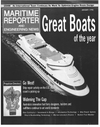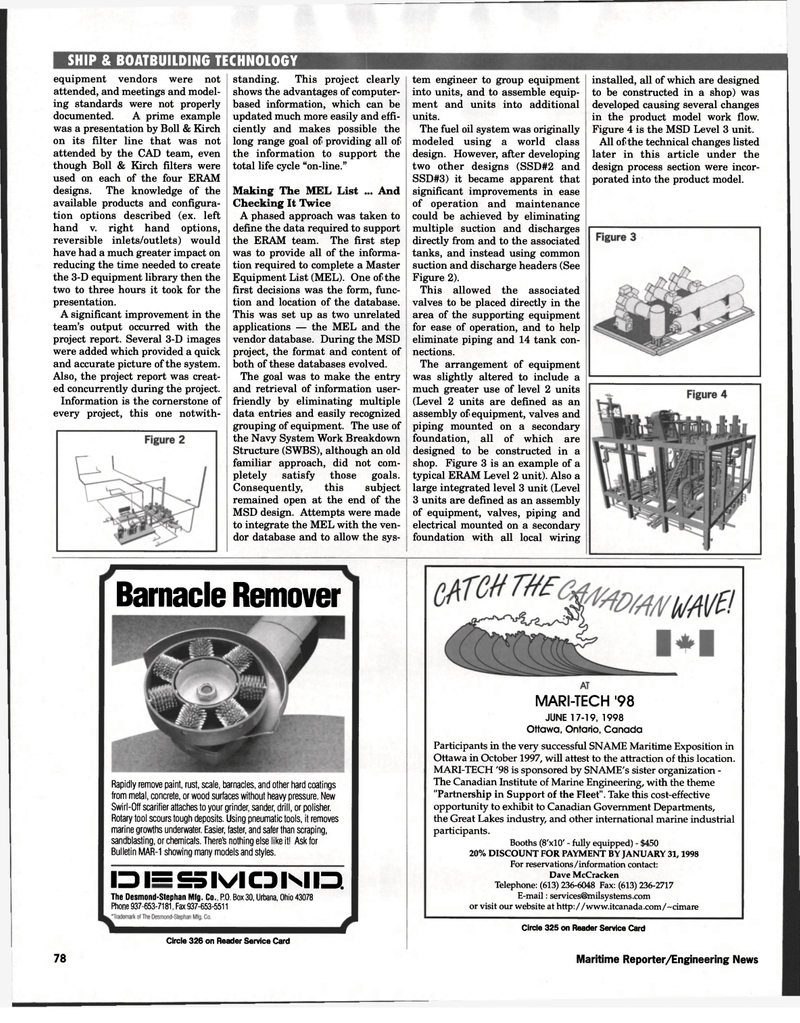
Page 78: of Maritime Reporter Magazine (January 1998)
Read this page in Pdf, Flash or Html5 edition of January 1998 Maritime Reporter Magazine
SHIP & BOATBUILDING TECHNOLOGY equipment vendors were not attended, and meetings and model- ing standards were not properly documented. A prime example was a presentation by Boll & Kirch on its filter line that was not attended by the CAD team, even though Boll & Kirch filters were used on each of the four ERAM designs. The knowledge of the available products and configura- tion options described (ex. left hand v. right hand options, reversible inlets/outlets) would have had a much greater impact on reducing the time needed to create the 3-D equipment library then the two to three hours it took for the presentation.
A significant improvement in the team's output occurred with the project report. Several 3-D images were added which provided a quick and accurate picture of the system.
Also, the project report was creat- ed concurrently during the project.
Information is the cornerstone of every project, this one notwith- standing. This project clearly shows the advantages of computer- based information, which can be updated much more easily and effi- ciently and makes possible the long range goal of providing all of the information to support the total life cycle "on-line."
Making The MEL List ... And
Checking It Twice
A phased approach was taken to define the data required to support the ERAM team. The first step was to provide all of the informa- tion required to complete a Master
Equipment List (MEL). One of the first decisions was the form, func- tion and location of the database.
This was set up as two unrelated applications — the MEL and the vendor database. During the MSD project, the format and content of both of these databases evolved.
The goal was to make the entry and retrieval of information user- friendly by eliminating multiple data entries and easily recognized grouping of equipment. The use of the Navy System Work Breakdown
Structure (SWBS), although an old familiar approach, did not com- pletely satisfy those goals.
Consequently, this subject remained open at the end of the
MSD design. Attempts were made to integrate the MEL with the ven- dor database and to allow the sys- tem engineer to group equipment into units, and to assemble equip- ment and units into additional units.
The fuel oil system was originally modeled using a world class design. However, after developing two other designs (SSD#2 and
SSD#3) it became apparent that significant improvements in ease of operation and maintenance could be achieved by eliminating multiple suction and discharges directly from and to the associated tanks, and instead using common suction and discharge headers (See
Figure 2).
This allowed the associated valves to be placed directly in the area of the supporting equipment for ease of operation, and to help eliminate piping and 14 tank con- nections.
The arrangement of equipment was slightly altered to include a much greater use of level 2 units (Level 2 units are defined as an assembly of equipment, valves and piping mounted on a secondary foundation, all of which are designed to be constructed in a shop. Figure 3 is an example of a typical ERAM Level 2 unit). Also a large integrated level 3 unit (Level 3 units are defined as an assembly of equipment, valves, piping and electrical mounted on a secondary foundation with all local wiring installed, all of which are designed to be constructed in a shop) was developed causing several changes in the product model work flow.
Figure 4 is the MSD Level 3 unit.
All of the technical changes listed later in this article under the design process section were incor- porated into the product model.
Barnacle Remover
Rapidly remove paint, rust, scale, barnacles, and other hard coatings from metal, concrete, or wood surfaces without heavy pressure. New
Swirl-Off scarifier attaches to your grinder, sander, drill, or polisher.
Rotary tool scours tough deposits. Using pneumatic tools, it removes marine growths underwater. Easier, faster, and safer than scraping, sandblasting, or chemicals. There's nothing else like it! Ask for
Bulletin MAR-1 showing many models and styles.
I=)I=S5K/IC3IMD.
The Desmond-Stephan Mfg. Co., P.O. Box30, Urbana, Ohio 43078
Phone 937-653-7181, Fax 937-653-5511
Circle 326 on Reader Service Card
MARI-TECH '98
JUNE 17-19, 1998
Ottawa, Ontario, Canada
Participants in the very successful SNAME Maritime Exposition in
Ottawa in October 1997, will attest to the attraction of this location.
MARI-TECH '98 is sponsored by SNAME's sister organization -
The Canadian Institute of Marine Engineering, with the theme "Partnership in Support of the Fleet". Take this cost-effective opportunity to exhibit to Canadian Government Departments, the Great Lakes industry, and other international marine industrial participants.
Booths (8'xlO' - fully equipped) - $450 20% DISCOUNT FOR PAYMENT BY JANUARY 31,1998
For reservations/information contact:
Dave McCracken
Telephone: (613) 236-6048 Fax: (613) 236-2717
E-mail: [email protected] or visit our website at http://www.itcanada.com/~cimare
Circle 325 on Reader Service Card 78 Maritime Reporter/Engineering News

 77
77

 79
79
